Broadband Halogen Fiber Optic Illuminators
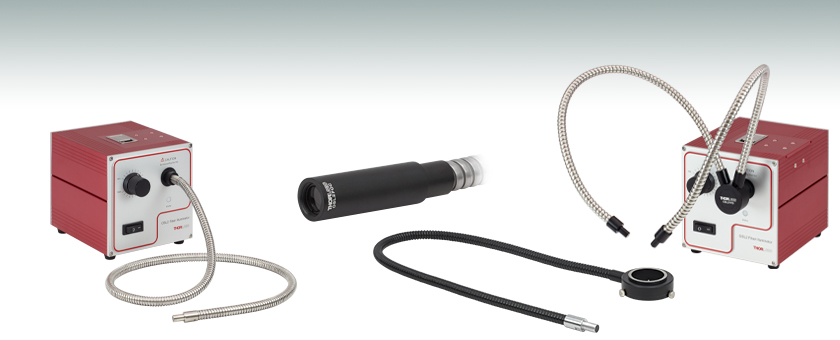
- 150 W High-Output Halogen Lamps with Variable Intensity Control
- 91 cm (36") Long Fiber Bundle Included
- Optional Accessories Include Gooseneck Fiber Bundles,
Microscope Ring Illuminator, and Collimation Packages
OSL2COL
Collimation Package (Shown Attached to OSL2YFB Fiber Bundle)
FRI61F50
Microscope Ring Illuminator
Application Idea
OSL2YFB Gooseneck Y-Bundle with the OSL2 Light Source
High-Intensity Fiber-Coupled Illuminator, Fiber Bundle Included
OSL2

Please Wait
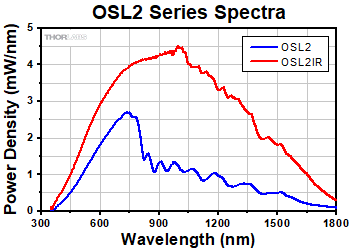
Click to Enlarge
Click to Download Raw Data
These spectra represent the output of the OSL2B bulb installed in the OSL2 light source (blue line) and the OSL2BIR bulb installed in the OSL2IR light source (red line). The OSL2B bulb has an integrated hot mirror to block most IR light. The OSL2BIR bulb has an aluminum-coated reflector for enhanced performance in the infrared. These spectra are taken with the included fiber bundle and account for attenuation within the fiber bundle.
Features
- High-Output 150 W Bulbs with 3200 K Color Temperature
- OSL2 Comes with Pre-Installed OSL2B Bulb with Integrated Hot Mirror to Block Most IR Light
- OSL2IR Comes with Pre-Installed OSL2BIR Bulb with Aluminum-Coated Reflector for Enhanced IR Performance
- DC-Coupled Illuminators for Stable, Consistent Light Output
- Variable Intensity Control via Front Panel Knob (0% to 100%)
- Rugged Design with Thermal Safety Cutoff
- 91 cm (36") Long, Ø6.4 mm (Ø0.25") Core Fiber Bundle Included
- Internally SM1-Threaded (1.035"-40) Output Port
Thorlabs' OSL2 and OSL2IR High-Intensity Fiber Light Sources deliver white light for brightfield microscopy, laboratory, and illumination applications. The output illumination intensity is exponentially variable from 0 to 100% using a knob on the front of the unit. The 150 W EKE halogen bulbs have a 3200 K color temperature (see the graph to the right) and are user replaceable with optional bulbs sold below. These portable fiber-coupled light sources are compatible with 100 to 120 VAC as well as 220 to 240 VAC and includes a location-specific power cord.
A 91 cm (36") long fiber bundle with a Ø6.4 mm (Ø0.25") effective core is included with the OSL2 and OSL2IR light sources. To adapt the fiber bundle output to an optomechanical setup, we recommend using our AD8F mounting adapter (see photo to the left), which provides external SM1 (1.035"-40) threading for easy integration with any of our SM1-threaded components. In particular, this adapter can be used to connect the OSL2 or OSL2IR to a Cerna® microscope for both epi-illumination and trans-illumination; see the Use with Cerna tab for details.
The fiber illuminator's output port also has internal, 3.5 mm deep SM1 threads. The unit is shipped with a fiber bundle adapter installed in these threads. By removing the fiber bundle mounting adapter from the output port, standard fiber connector adapters (sold below) and other SM1-threaded components can be attached to the light source.
Accessories
We offer collimation and focusing packages for the end of the fiber bundle, single-output fiber bundles, a bifurcated fiber Y-bundle with two goosenecked legs, and a microscope ring illuminator. The single-output fiber bundles are available in two varieties: a metal-jacketed replacement bundle for the included bundle and a gooseneck bundle for increased rigidity and easy manual positioning. Longer length fiber bundles are also available as a custom order by contacting Tech Support.
Four replacement bulbs for use with our high-intensity fiber light sources are available below, along with their emission spectra. The OSL2B and OSL1B bulbs are identical to the bulbs used in the OSL2 and the former OSL1 light sources, respectively, and emit in the visible spectrum. The OSL2B2 bulb also emits in the visible spectrum and provides greater power output at the expense of bulb lifetime. Lastly, the OSL2BIR bulb is used in the OSL2IR light source and offers enhanced emission in the near infrared through the use of an aluminum-coated reflector. Further details on compatible bulbs are also provided on the Specs tab.
If a higher color temperature is desired, our color-balancing filters can be used to attenuate red light from the OSL2 light source while passing blue light. This results in a beam with a higher color temperature and lower total power.

Click to Enlarge
Click to Download Raw Data
These spectra represent the output of the OSL2B bulb installed in the OSL2 light source (blue line) and the OSL2BIR bulb installed in the OSL2IR light source (red line). The OSL2B bulb has an integrated hot mirror to block most IR light. The OSL2BIR bulb has an aluminum-coated reflector for enhanced performance in the infrared. These spectra are taken with the included fiber bundle and the attenuation within the fiber bundle is accounted for.
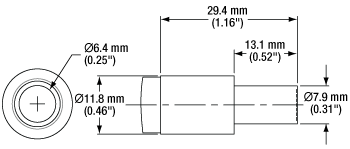
Click to Enlarge
Output End of the Included Fiber Bundle
| Item # | OSL2a | OSL2IRa |
|---|---|---|
| Light Source Specs | ||
| Power at Fiber Tip | 1.4 W at Maximum Bulb Intensity | 3.8 W at Maximum Bulb Intensity |
| Color Temperature of Included Bulb | 3200 K at Maximum Bulb Intensity | |
| Operating Wavelength Range | 400 - 1600 nm (Typical) | 400 - 1750 nm (Typical) |
| Color Rendering Index (CRI) | 90% | |
| Intensity Adjustment Range | 0 to 100% | |
| Time to Full Brightness | 4 s Typical, 7 s Maximum | |
| Output Power Stability | ±0.5% over 8 Hours | ±0.8% over 8 Hours |
| Lamp Lifetime | 1000 Hours to 50% Brightness | 200 Hours to 50% Brightness |
| Included Bulbb | OSL2B (150 W, 3200 K, EKE/10H) | OSL2BIR (150 W, 3200 K, Enhanced IR, EKE/AL) |
| Other Compatible Bulb Typesb | OSL2B2 (150 W, 3400 K, EJV) OSL2BIR (150 W, 3200 K, Enhanced IR, EKE/AL) OSL1B (150 W, 3250 K, EKE) |
OSL2B (150 W, 3200 K, EKE/10H) OSL2B2 (150 W, 3400 K, EJV) OSL1B (150 W, 3250 K, EKE) |
| Input Voltage | 100 - 120 VAC, 50/60 Hz 200 - 240 VAC, 50/60 Hz |
|
| Power Consumption | 200 W at Maximum Bulb Intensity | |
| Fuse Type | 3 A, 250 V, 5 x 20 mm | |
| Operating Temperaturec | -20 to 40 °C (-4 to 104 °F) | |
| Humidity Range | 0 - 80%, Non-Condensing | |
| Weight | 2.9 lbs (1.3 kg) | |
| Fiber Bundle Specs | ||
| Fiber Bundle Lengthd | 91 cm (36") | |
| Fiber Bundle NA | 0.57 | |
| Fiber Bundle Effective Core Diameter | Ø6.4 mm (Ø0.25") | |
| Operating Wavelength Rangee | 390 - 1750 nm | |
| Fiber Bundle Attenuation | <0.6 dB/m at 940 nm | |
| Number of Fibers | 6718 (Calculated) | |
| Fiber Core Diameterf | 50 µm | |
| Fiber Cladding Diameterf | 52.5 µm | |
| Bundle Minimum Bend Radius | 100 mm | |
| Operating Temperaturec | 0 to 180 °C (32 to 356 °F) | |
Click to Download Raw Data
The typical long-term and short-term output intensity stability of the OSL2 and OSL2IR are shown above.
| Components for Cerna® Compatibility |
|---|
| Epi-Illumination |
| WFA2001 Epi-Illuminator Module |
| AD8F Ø8 mm to SM1 (1.035"-40) Adapter |
| Trans-Illumination |
| WFA1000 Trans-Illumination Module or WFA1100 Dodt Gradient Contrast Module |
| AD8F Ø8 mm to SM1 Adapter |
| CP33(/M) SM1-Threaded 30 mm Cage Plate (Qty. 2) |
| LA1134 or LA1134-A Ø1" Plano-Convex Lensa (f = 60.0 mm) |
| ER3-P4 3" Cage Rods |
Using the Broadband Halogen Lamp in Cerna® Microscope Systems
The OSL2 high-intensity light source provides effective broad-spectrum illumination for brightfield and reflected light microscopy. It can be used in both epi-illumination and trans-illumination configurations within the Cerna microscopy platform.
Installation on Epi-Illuminator Module
The OSL2 is compatible with a Cerna microscope via the single-cube epi-illuminator module (Item # WFA2001), which contains anti-reflective (AR)-coated optics with <0.5% average reflectance per surface over the 350 - 700 nm wavelength range. The halogen lamp fiber bundle and epi-illuminator module are connected together by an SM1-threaded (1.035"-40) adapter (Item # AD8F). First thread the adapter onto the epi-illuminator module, then secure the fiber bundle with the nylon-tipped setscrews on the adapter [1/16" (1.5 mm) hex]. The epi-illuminator module accepts an uncollimated light source, so no collimation package is necessary.
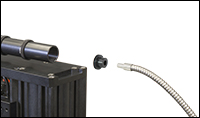 Click to Enlarge
Click to EnlargeThread the AD8F adapter into the WFA2001 epi-illuminator module.
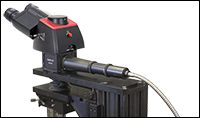 Click to Enlarge
Click to EnlargeSecure the fiber bundle with setscrews on the AD8F (1/16" [1.5 mm] hex).
Installation on Trans-Illumination Module
Because the WFA1000 and WFA1100 trans-illumination modules need a Ø1" collimated light source secured to a 30 mm cage system to provide even illumination, the emitted beam from the OSL2 must be collimated by a plano-convex lens with a focal length of 60.0 mm. We recommend using either the LA1134 or LA1134-A N-BK7 plano-convex lens. The LA1134 lens is uncoated and will provide relatively even transmission of the entire OSL2 spectrum; the LA1134-A features an AR coating that provides improved transmission in the 350 - 700 nm range but worse transmission above 700 nm. See the Coatings Tutorial for details. A slightly longer focal length lens can be substituted, but will result in dimmer illumination at the sample plane.
To assemble the cage system for the OSL2, first mount the lens onto a SM1 (1.035"-40) threaded 30 mm cage plate (Item # CP33(/M)) using the included retaining rings (Item # SM1RR). The other cage plate secures the Ø8 mm to SM1 adapter (Item # AD8F); utilize an additional retaining ring to set the adapter at a particular position. Attach the cage rods (Item # ER3-P4) to the trans-illumination module by removing the dust cover on the side of the module with a 1.5 mm hex, then locking the cage rods into place using the exposed side-locking 4-40 setscrews (0.05" hex). Once the cage rods are secure, slide the cage plate with the optic onto the rods so that the convex side of the lens faces the trans-illumination module. This is then followed by the cage plate with the AD8F adapter. The cage plates are secured to the cage rods using side-locking 4-40 setscrews. Once the assembly is secure, mount the tip of the fiber bundle onto the end of the collimation package using two 6-32 setscrews [1/16" (1.5 mm) hex]. See the diagram and images below for a visual depiction of this assembly.
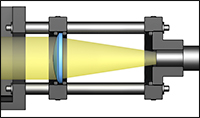 Click to Enlarge
Click to EnlargeCollimating the OSL2
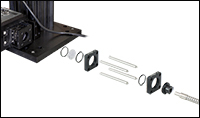 Click to Enlarge
Click to EnlargeCage System Components Necessary for Collimation
 Click to Enlarge
Click to EnlargeSecure the cage assembly using the side-locking 4-40 setscrews on the trans-illumination module.
The cage plates should be separated such that the distance between the fiber tip and the plano side of the lens is 2.23" (56.7 mm), the back focal length of the lens. The cage system provides easy adjustment of the distance between the cage plates while maintaining alignment. Please contact Technical Support if you need further assistance with this installation.
| Posted Comments: | |
Lawal Adebayo
(posted 2023-09-26 15:42:08.65) Hi,
My name is Adebayo Lawal a Phd candidate at Case Western Reserve University. We have the OSL1 - High Intensity Fiber Light Source in our lab, however the product seems to be faulty.
The product powers on and the fan runs (one can verify by the sound it makes and by touching the device) but the bulb doesn't lit up.
Kindly advice on what can be done to fix this problem.
Thanks and best regards,
Lawal ksosnowski
(posted 2023-09-26 05:27:01.0) Hello Lawal, thanks for reaching out to Thorlabs, and sorry to hear of your issues with the OSL1 lamp. Though we no longer produce the full OSL1 lamp fixture we do still offer a replacement bulb for this as our part# OSL1B. If you notice a lack of electrical continuity in your current bulb then it may be worn out in which case a replacement should restore performance. I have reached out directly to discuss this further. María Castro Fernández
(posted 2023-05-11 15:07:13.35) Hello! I plan to use the OSL2BIR light source to obtain spectral signatures within the visible and near-infrared wavelength range. However, I see in the documentation of the FRI61F50 ring illuminator that its fiber bundle maximum operating wavelength is 900nm. Is it possible to operate in the near-infrared range effectively (until 1100nm at least)? Considering the 46% transmission of the ring illuminator, how much power should I expect to obtain, both in the visible and near-infrared ranges? ksosnowski
(posted 2023-05-16 01:42:26.0) Thank you for contacting Thorlabs. The transmission of FRI61F50 beyond 900nm is very low, so we do not recommend it for near-infrared application beyond 900nm. For using the FRI61F50 with OSL2, the total output will be similar to what can be achieved with a OSL2FB. Lionel Rudaz
(posted 2022-06-23 13:26:23.71) Hello,
I wanted to know if coupling this light source into a single mode fiber was possible ? cdolbashian
(posted 2022-06-24 04:06:18.0) Thanks for contacting Thorlabs. Unfortunately, since this cannot be considered a point source (and is highly divergent), the coupling efficiency into a few um core size single mode fiber is going to be very low ( <<1%). This comes from the restriction driven by the optical invariant, also known as etendue. user
(posted 2022-05-17 23:24:51.143) Following this sentence: "We recommend verifying that any other fiber bundle used with the OSL2 or OSL2IR light sources can sustain the heat from the bulb; please contact Tech Support with inquires." - Can one couple the OSL2 illuminator output into a multimode fiber patch cable (such as the 105um core, .22 NA M43L01 cable for example) using the suggested SM1FC2 adapter? Or are there other, more preferable solutions for this? Thanks jgreschler
(posted 2022-05-21 10:03:23.0) Thank you for reaching out to Thorlabs. In the specs tab of the OSL2 lamp page in footnote c it notes that the combined operating temperature of the lamp and the fiber bundle is 0-40C, the fiber patch cable you have indicated has a temperature range of up to 85C so this will be fine. Jintao Kong
(posted 2020-06-13 17:04:21.62) Can you provide Y-type boudle with core diameter like OSL2FB and shape like BF19Y2LS02? YLohia
(posted 2020-06-15 10:12:48.0) Thank you for contacting Thorlabs. We offer the OSL2YFB, which is the Y-shaped bundle similar to the OSL2FB. Custom items can be requested by emailing your local Thorlabs Tech Support team (in your case, europe@thorlabs.com). We will contact you directly regarding this. user
(posted 2019-12-25 16:19:06.103) by using the OSL2COL, is the beam from the fiber bundle perfectly collimated for microscopy or only roughly collimated. nbayconich
(posted 2019-12-30 09:44:20.0) Thank you for contacting Thorlabs. The OSL2COL includes a LA1289 lens which provides a rough collimation for the OSL2 source. The half angle of the beam will be between 5~8 degrees Tom Baker
(posted 2019-05-15 20:46:42.647) What is the M60/1 threading compatible with - I can't seem to find any adapters on the adapters page in that size. What filter mounts/sets will work? llamb
(posted 2019-05-23 04:25:05.0) Thank you for your feedback. We do not currently have any M60 x 1.0 thread adapters available in our catalog unfortunately. This idea has been noted in our internal product forum for further review. marcin.bartosik
(posted 2018-08-10 14:21:07.573) Hello!
Please let me know if i could buy the OSL2 without the Fiber Bundle (I would by only an SMA adapter)?
Have a nice day,
Marcin YLohia
(posted 2018-08-10 10:08:00.0) Hello Marcin, thank you for contacting Thorlabs. We can offer this item without the fiber. Quotes for customized items can be requested at techsupport@thorlabs.com. ms293
(posted 2018-02-15 14:42:58.697) Hello
I want to mount the OSL2YFB into a cage system and was wondering which adapter is used to couple the OSL2YFB to the OSL2?
Cheers. YLohia
(posted 2018-03-31 02:05:51.0) Hello, thank you for contacting Thorlabs. We currently use a version of the AD8F adapter to mount the OSL2 fiber bundles. You can use this with any internally SM1-threaded optomechanical component, including the CP02 cage plate. pgutierr
(posted 2015-11-10 17:16:39.737) Dear ThorLabs,
How does the variable intensity control work for the OSL2?
By physically blocking the light or dimming the halogen lamp?
Best
Pablo Gutierrez
Electronic Engineering Dpt.
European Southern Observatory
Karl-Schwarzschild-Str. 2
85748 Garching, Germany jlow
(posted 2015-11-16 02:07:40.0) Response from Jeremy at Thorlabs: The variable intensity control works by dimming the halogen lamp. littlefox121
(posted 2013-08-16 17:38:58.977) What is the approximate output power if 150W light source is output coupled by fiber bundle? tcohen
(posted 2013-08-29 16:08:00.0) Response from Tim at Thorlabs: Although these values can vary, the supplied fiber bundle will be ~500mW. A 7 fiber, 550um core, .22NA would be ~150mW. Single fibers will be less. For example, 1000um, .39NA would be ~80mW. tcohen
(posted 2012-08-21 13:44:00.0) Response from Tim at Thorlabs: The output of this source is very high intensity and divergent. If prepared for the losses one will have during coupling, this can be done with aspheric condenser lenses or achromats. A general setup is provided below by Javier. As an alternative, we offer the OSL1-SMA which can directly mate the OSL1 to an SMA 905 connectorized fiber bundle. I will contact you directly to go over these options with you. czl0579
(posted 2012-08-20 12:52:57.0) Do you have some suggestions that how to couple this light source into a multimode fiber (M14L02)? We lost the original fiber bundle and now use a light guide instead. Also, do you have some suggestions to couple the source to it? Thanks. anqi.zhang
(posted 2012-08-17 10:00:00.0) Any suggestion regarding how to couple this light source into a 50 micron core fiber? tcohen
(posted 2012-04-16 10:39:00.0) Response from Tim at Thorlabs: Thank you for your feedback! We are constantly looking for ways to improve our products and I will discuss your suggestion with our production team. user
(posted 2012-04-12 15:47:27.0) would be cool if there was an inexpensive way to control this remotely. Only other option I can find is your $2k high power source. lmorgus
(posted 2011-03-31 14:41:00.0) Response from Laurie at Thorlabs to the anonymous poster: Thank you for taking the time to let us know that one of our links is broken. We will fixed it right away and apologize for the inconvenience. user
(posted 2011-03-31 13:58:58.0) Catalog page PDF download link for the OSL1 is broken Thorlabs
(posted 2010-11-08 17:48:28.0) Response from Javier at Thorlabs to last poster: we are currently gathering this information for you. Please contact us at techsupport@thorlabs.com so that we can can keep you updated on this request. user
(posted 2010-11-08 12:29:06.0) Is it possible to label the spectral density of the plot on the overview tab with units of uW/nm, as is done for the HPLS-30-04? Thorlabs
(posted 2010-09-10 15:45:00.0) Response from Javier at Thorlabs to yuj210: I will contact you shortly. yuj210
(posted 2010-09-09 13:53:14.0) Dear Javier, would you reply my following inquiries ASAP? I sent mails, left voice message also. Thanks. Thorlabs
(posted 2010-09-08 19:10:19.0) Response from Javier at Thorlabs to yuj210: Regarding the OSL1, the output from the fiber is very divergent (NA in the range of 0.5-0.6), so it is very difficult to achieve a well collimated output. In order to collect the output from the fiber tip, I would recommend using one of our aspheric condenser lenses. A good candidate is the ACL5040:
http://www.thorlabs.com/NewGroupPage9.cfm?ObjectGroup_ID=3835
This lens has a diameter of 50 mm, a focal length of 40 mm, and a numerical aperture of 0.55. This lens can be mounted onto the LMR2 mount: http://www.thorlabs.com/NewGroupPage9.cfm?ObjectGroup_ID=1433&pn=LMR2
Now, in order to focus the output from the OSL1 into multimode fiber, you will most likely need to reduce the size of the beam. A 20X beam expander used as a reducer may be suitable:
http://www.thorlabs.com/NewGroupPage9.cfm?ObjectGroup_ID=1580
I will contact you directly to discuss the details of your application, including the fiber specifications. yuj210
(posted 2010-09-08 00:56:30.0) Im planning an experiment using this OSL1. Let me ask something. If I dont care money much, what would be the best choice to get collimated beam with OSL1. Im thinking of chromatic lens, AC127-019-A-ML . I need your comment and recommend also. Thanks. Thorlabs
(posted 2010-08-06 11:45:02.0) Response from Javier at Thorlabs to last poster: Thank you for your feedback. We have added the light output spec in lux. user
(posted 2010-08-06 11:11:35.0) Who uses "foot candles" these days, try to make to the modern world Adam
(posted 2010-05-12 16:10:04.0) A response from Adam at Thorlabs to dellapir: We took one from stock and measured the power. The minimum power is 50mW and the maximum power is 1.8W. The change in the power is exponetial as you rotate the potentiometer. dellapir
(posted 2010-05-12 12:46:23.0) Mr./Mrs:
We´ve bought your OSL1-EC lamp with optical fiber. As you know it is possible to change the intensity of the lamp, and this is the information that we need.
Can you tell us what the minimum and maximum intensity emitted by the lamp? The change , which is possible using the potentiometer marked on the lamp, is a linear or exponential?
Thank you!!!
Best regards.
Monica Della Pirriera
MNT group
Univeridad Poltecnica de Cataluña apalmentieri
(posted 2009-12-18 11:37:15.0) A response from Adam at Thorlabs: I would like to discuss this further with you. I will send you an email to try and find out the exact parameters that you are looking for. juanpamunoz
(posted 2009-12-18 09:23:20.0) Hi, i´m using your lamp in the "Opto Electronic Lab of UNIVERSIDAD DE CONCEPCION, CHILE", and i would like to know more specifications about the "High-Intensity Fiber Light Source OSL1-EC", like SNR coefficient and another kind of parameters.
Thus, i could add more accuracy to my thesis measurements.
Thanks a lot.
Juan Pablo Muñoz Carmona.
Thesis Student.
Civil Engineering Electronics.
Universidad de Concepción. jens
(posted 2009-06-09 08:12:28.0) A reply from Jens at Thorlabs: coupling of this 150W light source into a single mode fiber is virtually impossible. We might be able to offer a different solution if we get additional information regarding your setup. I will contact you directly for that. user
(posted 2009-06-09 04:21:03.0) what adapter do i use to couple the SMF(core 9um)? jens
(posted 2009-05-18 17:45:55.0) An answer from Jens at Thorlabs: the output power at 1100nm is virtually zero. We probably can offer a custom solution where we would replace the light bulb inside the unit. We will contact you with a quotation directly. As for the collimation you could try using a pinhole but if you need better collimation since you may want to guide the light over a longer distance a plano-concave singlet lens such as our BK7 lens LA1540 can be used. The lens will need to be place 15mm in front of the output. The output fiber bundle can be hold in place using our AD12F adapter. Using that adapter the fiber end can be mounted in a cage system using cage plate CP02. We will contact you directly as soon as possible. nutik
(posted 2009-05-18 16:55:54.0) Do you have any accessories for this light source to have a parallel output beam or a focused beam?
What is the intensity of the output light at 1100nm? Tyler
(posted 2008-08-14 10:54:17.0) A response from Tyler at Thorlabs to sai: The blackbody radiation equation shown on the specs tab is really only intended to give the user of an OSL1 an idea of the spectral distribution of the light emitted from the halogen lamp. In reality, the lamp is not a perfect blackbody source and certainly the glass bulb and MM fiber bundle will have some absorption profile that will modify the emitted intensity versus wavelength even further from an ideal blackbody source. sai
(posted 2008-08-04 11:03:38.0) I have a question regarding the formula you have used to calculate the intensity in the "specs" tab. Will this give me power density (Watts per cubic meter)? If yes, can you please tell me how to find the intensity in terms of Power/ Surface area (Watts per sq meter)? Thanks! Tyler
(posted 2008-08-01 13:58:59.0) A response from Tyler at Thorlabs to smitachat2001: Thank you for your interest in the OSL1. There is no specific reason why the OSL1 halogen lamp cannot be left on continuously. The housing will get quite warm over time but if the unit is in a room temperature environment and the airflow to the cooling fan is not blocked the lamp will function properly. The one drawback to using the lamp continuously is that the hotter the lamp is the shorter its lifetime so for continuous use it might be wise to improve the cooling of the lamp. smitachat2001
(posted 2008-07-30 21:20:50.0) It is certainly usefull product but it looks as if they are not meant to be used for 24 hours, which makes them restricted for many lab purposes. Tyler
(posted 2008-06-26 16:29:35.0) A response from Tyler at Thorlabs to leosis: I have added a plot of the theoretical emission intensity as a function of wavelength to the "Specs" tab. The light will appear white, but as you can see from the plot, the emission intensity will peak near 910 nm when the unit is at maximum power. leosis
(posted 2008-06-23 07:20:25.0) i want to know the operating wavelengt of this product.
please, reply to me about this information. Tyler
(posted 2008-06-05 12:16:30.0) A response from Tyler at Thorlabs: The divergence angle of the fiber bundle is not a controlled specification and as a result cannot be guaranteed. However, I tested a OSL1 and measured a divergence angle of 33 degrees (This was determined by measuring the spot diameter at several distances from the fiber bundle tip and fitting the data to a straight line. The inverse tangent of the slope of the fit line was 33 degrees.) user
(posted 2008-06-05 10:13:02.0) Whats the divergence angle of the fiber bundle at the output tip? |
Below is a selection guide for all of our white-light, broadband, lamp-based light sources. In addition to these sources, Thorlabs also offers unmounted white-light LEDs, white-light mounted LEDs, white-light fiber-coupled LEDs, and high-powered, white-light Solis® LEDs.
| Broadband Light Source Selection Guide | ||||||||||
|---|---|---|---|---|---|---|---|---|---|---|
| Item # | (Click to Enlarge; Not to Scale) |
Emitter Type | Wavelength Range (Click for Plot) |
Output Coupling | Output Power | Lamp Electrical Power |
Color Temperature |
Lamp Lifetime |
Replacement Lamp |
|
| SLS204 | Deuterium | 200 - 700 nm | Free Space or Fiber Coupled (SMA) |
2 mWa 0.1 mWb (Typ.) |
30 W | N/A | 2000 hc | SLS254B | ||
| SLS205 | Xenon Arc | 240 - 1200 nm | Free Space or Fiber Coupled (SMA) |
290 mWa 5 mWd (Typ.) |
75 W | 5800 Ka 5400 Kd |
2000 hc | SLS255B | ||
| SLS401 | Xenon Arc | 240 - 2400 nm | Free Spacee | >1.3 Wa | 150 W | 5800 K | 2000 hc | SLS401Bf or SLS402B |
||
| SLS402 | Mercury-Xenon Arc | 240 - 2400 nm | Free Spacee | >1.3 Wa | 150 W | 6000 K | 2000 hc | SLS401B or SLS402Bf |
||
| SLS302 | Quartz Tungsten-Halogen |
360 - 2500 nm | Free Spacee | >10 Wa | 150 W | 3400 K | 1000 hg | SLS301B | ||
| SLS201L(/M) | Quartz Tungsten-Halogen |
360 - 2600 nm | Free Spacee or Fiber Coupled (SMA) |
500 mWa 10 mWh |
9 W | 2796 K | 10 000 h | SLS251 | ||
| SLS301 | Quartz Tungsten-Halogen |
360 - 3800 nm | Free Spacee | >1.6 Wa | 150 W | 3400 K | 1000 hg | SLS301B | ||
| SLS603 | Xenon Arc | 380 - 780 nm | Ø3 mm Liquid Light Guide |
>7 Wh | 300 W | 6000 Ki | 1000 hc | SLS600B | ||
| SLS605 | Xenon Arc | 380 - 780 nm | Ø5 mm Liquid Light Guide |
>15 Wh | 300 W | 6000 Ki | 1000 hc | SLS600B | ||
| OSL2 | Tungsten-Halogen | 400 - 1600 nm (Typical) |
Fiber Bundle | 1.4 Wk | 150 W | 3200 K | 1000 hc | OSL2Bf, OSL2B2, or OSL2BIR |
||
| OSL2IR | Tungsten-Halogen | 400 - 1750 nm (Typical) |
Fiber Bundle | 3.8 Wk | 150 W | 3200 K | 200 hc | OSL2B, OSL2B2, or OSL2BIRf |
||
| QTH10(/M) | Quartz Tungsten-Halogen |
400 - 2200 nm | Free Space | 50 mW (Typ.) | 10 W | 2800 Kl (Typ.) | 2000 h | QTH10B | ||
| SLS203F(/M) | Silicon Carbide Globar | 500 nm - 9 µm | Free Spacee or Fiber Coupled (SMA) |
1.8 Wa | 24 W | 1500 K | 10 000 h | SLS253 | ||
| SLS303 | Silicon Nitride Globar | 550 nm - 15 µm | Free Space | 4.5 Wa | 70 W | 1200 K | 5000 hg | SLS303B | ||

- 150 W, 3200 K Halogen Bulbs
- OSL2 Comes with Pre-Installed OSL2B Bulb with Integrated Hot Mirror to Block Most IR Light
- OSL2IR Comes with Pre-Installed OSL2BIR Bulb with Aluminum-Coated Reflector for Enhanced IR Performance
- Continuously Variable Output Power via Front Panel Knob
- SM1-Threaded Output Port with 91 cm (36") Long Fiber Bundle
Thorlabs' High-Intensity Fiber-Coupled Light Sources are designed for illumination of brightfield microscopy setups and general-purpose laboratory use. A removable, 91 cm (36") long, Ø6.4 mm (Ø0.25") effective core fiber bundle is included with each light source. Replacement bundles are available below. Additionally, each light source has an internally SM1-threaded (1.035"-40) output port for custom integration into optomechanical setups.
These light sources have a built-in protection mechanism to prevent the unit from overheating and to turn off the lamp when the access door is opened. The LED indicator on the front panel is green during normal operation. If the unit overheats, power to the lamp is cut off and the LED turns red. If the access door is opened during normal operation, power to the lamp and the LED are cut off.
The OSL2 comes with a pre-installed OSL2B bulb that has an integrated hot mirror that blocks the majority of the IR light and has a typical wavelength range of 400 - 1600 nm. The OSL2IR comes with the OSL2BIR bulb which provides enhanced output in the near-IR due to the aluminum-coated reflector and lack of integrated hot mirror; it has a typical wavelength range of 400 - 1750 nm. Please see the Specs tab for more details.
The OSL2 and OSL2IR have built-in universal power supplies and include a location-specific detachable power cord. Additional user-replaceable light bulbs can be purchased below. To order the OSL2 or OSL2IR without the included fiber bundle, or for general custom order inquiries, please contact Tech Support.

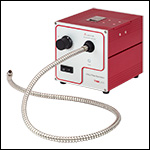
Click to Enlarge
OSL2RFB Gooseneck Bundle Angled Upward
- Replacement Fiber Bundles for OSL2 and OSL2IR Light Sources
- Gooseneck Bundles Provide Added Rigidity for Easy Manual Positioning
- Y-Bundle Provides Two Independently Positionable Beams
- Also Compatible with the Former OSL1 Light Source
Thorlabs offers fiber bundles designed to be used with the OSL2 and OSL2IR Fiber Light Sources sold above. These cables have fiber tips with Ø7.9 mm (Ø0.31") outer dimensions, enabling them to be used in place of the fiber bundle included with the OSL2 and OSL2IR.
Single-Output Fiber Bundle
The OSL2FB Single-Output Fiber Bundle has a flexible stainless-steel housing and is a direct replacement for the bundle included with the OSL2 and OSL2IR Light Sources.
Gooseneck Single-Output Fiber Bundle
The OSL2RFB Gooseneck Single-Output Fiber Bundle has the same fiber configuration as the bundle included with the OSL2 and OSL2IR, but has a gooseneck jacket for stability and easy manual positioning. The gooseneck jacket allows the bundle to maintain its position once it has been set.
Gooseneck Y-Bundle
The OSL2YFB Gooseneck Y-Bundle (Bifurcated) Cable splits the output of the fiber light source into two independently positionable beams, allowing larger work areas to be illuminated. Unlike the fiber bundle included with the OSL2 and OSL2IR, each leg of this bifurcated cable has a gooseneck jacket for easy manual positioning.
| Item # | OSL2FB | OSL2RFB | OSL2YFB |
|---|---|---|---|
| Description | Single-Output Bundle | Gooseneck Single-Output Bundle |
Gooseneck Y-Bundle |
| Fiber Bundle Length | 91 cm (36") | 91 cm (36") | 51.69 cm (20.35") |
| Bundle Effective Core Diametera | 6.4 mm (0.25") | 6.4 mm (0.25") | 4.52 mm (0.18") |
| Operating Wavelength Rangeb | 390 - 1750 nm | ||
| Numerical Aperture (NA) | 0.57 | ||
| Number of Fibers (Input) | 6718 (Calculated) | ||
| Fiber Core Diameterc | 50 µm | ||
| Fiber Cladding Diameterc | 52.5 µm | ||
| Fiber Material | Silica | ||
| Fiber Strength | >150 kg/mm2 | ||
| Attenuation (at 940 nm) | <0.6 dB/m | ||
| Minimum Bend Radius | 100 mm | 100 mm | 150 mm |
| Operating Temperature | 0 to 180 °C | 0 to 135 °C | 0 to 135 °C |

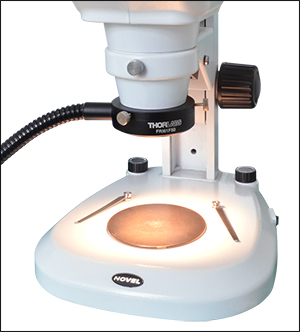
Click to Enlarge
FRI61F50 Mounted on a Zoom Microscope
- Large Working Distance Range: 50 - 170 mm
- Provides a Bright, Uniform, 360° Shadow-Free Illumination Area
- Provides Lighting Along the Microscope's Optical Axis
Thorlabs’ FRI61F50 Fiber Ring Illuminator has a 915 mm (36.02") long fiber bundle that couples light from our OSL2 and OSL2IR Fiber Light Sources into a Ø55 mm ring illuminator composed of five concentric fiber rings. The illuminator easily mounts onto most standard upright microscopes, such as the one shown to the right. It is secured using three thumbscrews, each of which is nylon tipped to produce adequate holding friction while preventing scratching or marring of the microscope. The fiber ring slips around any objective housing with a diameter of 60 mm or less.
Our fiber ring illuminator provides lighting very nearly aligned to the optical axis of the microscope that is shadow-free and uniform across the sample plane and throughout the entire working distance (WD) range. The use of 5 fiber rings increases the light intensity and WD range compared to illumination from a single fiber ring.
The fiber ring illuminator can be attached to the OSL2 or OSL2IR using the included adapter. The two nylon-tipped setscrews can be tightened using the included 1/16" hex key. Our AD16F adapter is available as a replacement.
The FRI61F50 has a WD range of 50 - 170 mm. Using the illuminator at distances greater than 170 mm will result in low-intensity, even illumination, which may be acceptable depending on the application.
Clicking the ![]() icon in the table below will open a window that contains additional specifications, performance data, and drawings.
icon in the table below will open a window that contains additional specifications, performance data, and drawings.

| Item # | OSL2COL | OSL2FOC |
|---|---|---|
| Description | Collimation Package | Focusing Package |
| Working Distance (WD) | N/A | 20 mm |
| Outer Dimensions | Ø17.8 mm x 47.3 mm | Ø17.8 mm x 56.0 mm |
| Threads on Output Port | Internal SM05 (0.535"-40) Threads | |
| Installed Lenses | LA1289 (1 Place) | LA1289 (2 Places) |
| Spot Size at 20 mm Working Distance |
Ø14.5 mm | Ø5.5 mm |
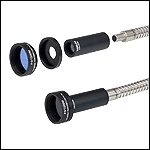
Click to Enlarge
OSL2COL Collimation Package with Mounted Ø25.0 mm Filter
- Packages to Collimate or Focus Light
- Designed for Use with the OSL2, OSL2IR, and Former OSL1 Light Sources
- Internal SM05 (0.535"-40) Threads at Output End for Thorlabs' Ø1/2" Lens Tubes
- Same Ø0.70" (Ø17.8 mm) Outer Diameter as Our Ø1/2" Lens Tubes
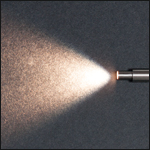
Click for Details
Fiber Bundle Without Optics
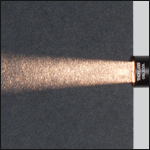
Click for Details
OSL2COL Collimating Package
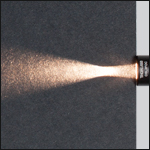
Click for Details
OSL2FOC Focusing Package
These collimation and focusing packages are designed for use with the fiber bundle included with the OSL2 and OSL2IR light sources; the fiber bundle included with the former OSL1 light source; and the replacement fiber bundles sold above. Two 6-32 setscrews that accept a 1/16" hex key secure the tip of the fiber bundle into the back of the collimation or focusing package. Internal SM05 (0.535"-40) threads on the front of each package and a 0.70" (17.8 mm) outer diameter make these directly compatible with our family of Ø1/2" lens tubes and components.
The photos to the left show the light output from the fiber bundle included with the OSL2 lamp. The photo to the far left shows the highly divergent beam emitted from the fiber bundle when it does not have a lens assembly attached. The other two photos show the beam when the collimation and focusing packages are attached.
The photo to the right illustrates one way to filter the output light from the OSL2 lamp using a mounted Ø25.0 mm filter. For details on alternate configurations using unmounted Ø12.5 mm or Ø25.0 mm filters, please click the photo.

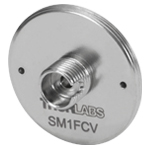
Click for Details
Vacuum-Compatible Wide Key FC/PC Adapter
- SM1-Threaded Disks with FC/PC or SMA Bulkhead
- Vacuum-Compatible Wide-Key FC/PC and SMA Versions Available
- Connect Standard Fiber Patch Cables or Fiber Bundles to our OSL2 and OSL2IR Light Sources
Thorlabs' Fiber Connector Adapters allow fiber patch cables and bundles with standard connectors to be used with the OSL2 and OSL2IR light sources (see photo to the right). Vacuum-compatible versions of the SM1FC and SM1SMA are available; the SM1SMAV and SM1FCV adapters are both vacuum compatible down to 10-10 Torr. Please note that the light output from fiber patch cables or bundles will be lower than that of the fiber bundle included with the OSL2 and OSL2IR, due to the smaller core or effective core diameter and lower NA. We recommend verifying that any other fiber bundle used with the OSL2 or OSL2IR light sources can sustain the heat from the bulb; please contact Tech Support with inquires.
To connect a patch cable, the fiber bundle adapter that comes preinstalled on the OSL2 or OSL2IR must first be removed by unscrewing it from the output port. Next, thread the fiber connector adapter into the output port. Each disk has four dimples, two in the front surface and two in the back surface, that allow it to be tightened from either side using either the SPW909 or SPW801 spanner wrench. The dimples do not go all the way through the disk so that the adapters can be used in light-tight applications. For Thorlabs' full line of SM1-threaded adapters, see Terminated Fiber Adapters.

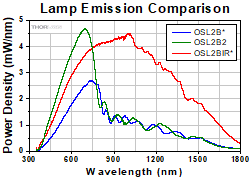
Click to Enlarge
Click for Raw Data
Comparison of Replacement Bulbs. These spectra are taken with the included fiber bundle and account for attenuation within the fiber bundle.
*OSL2B is Included with OSL2 Light Source
**OSL2BIR is Included with OSL2IR Light Source
- OSL2B: Replacement 3200 K Bulb for the Original Light Bulb Included with the OSL2 Light Source
- OSL2B2: 3400 K Bulb with Higher Output Power than OSL2B (See Graph Below)
- OSL2BIR: Replacement 3200 K Bulb with Enhanced Illumination in the Near Infrared for the Original Light Bulb Included with the OSL2IR Light Source
- Replacement Bulb for the Former OSL1 Light Source Sold Below
Thorlabs offers three different replacement bulbs for the OSL2 and OSL2IR High-Intensity Fiber Light Sources. The OSL2B is identical to the original bulb that comes with the OSL2, and the OSL2B2 is a high-power variant of the OSL2B. The OSL2BIR is identical to the original bulb that comes with the OSL2IR. The OSL2B and OSL2B2 bulbs each have an integrated hot mirror that blocks most of the IR light. In contrast, the OSL2BIR provides enhanced output in the near-IR due to the aluminum-coated reflector and lack of integrated hot mirror. The graph below compares the spectra and power of these bulbs. To view a spectrum and raw data for each individual bulb, click on the graph icons in the table below.
To install the replacement bulb in the OSL2 or OSL2IR sources, open the door on the top of the unit, as shown in the photo to the right, and remove the old bulb. Details are available in Chapter 5 of the OSL2 manual or OSL2IR manual.

The OSL1B replacement light bulb is identical to that included with our former OSL1 light source. The bulb has an integrated hot mirror that blocks most of the IR light. Click on the graph icon in the table to the right to view the bulb's emission spectrum.
To install the replacement bulb in the former OSL1 source, simply loosen the two fasteners on the front panel of the unit, slide out the bulb assembly, and remove the old bulb. Details are available in Chapter 4 of the OSL1 manual, available as a PDF here. The OSL1B bulb can also be installed in our OSL2 or OSL2IR light source by following the installation instructions in Chapter 5 of the OSL2 manual or OSL2IR manual.

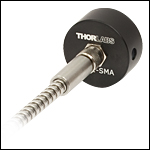
Click to Enlarge
SMA Fiber Bundle Attached to OSL1-SMA Adapter
The OSL1-SMA fiber bundle adapter allows multimode fiber bundles with SMA connectors to be used as the output of our former OSL1 fiber light source. Our fiber bundles with SMA connectors offer broader operating wavelength ranges than the fiber bundle included with the former OSL1 and the OSL2YFB bifurcated fiber bundle (sold above), and they are available in longer lengths.
The OSL1-SMA adapter inserts into the front panel of the former OSL1 unit and is secured by a thumbscrew. It is compatible with SMA905- and SMA906-style connectors.
Note: The OSL1-SMA is not compatible with our current OSL2 or OSL2IR light sources.
 Products Home
Products Home


















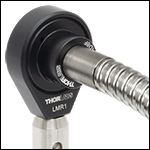
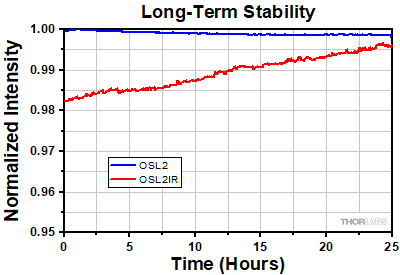
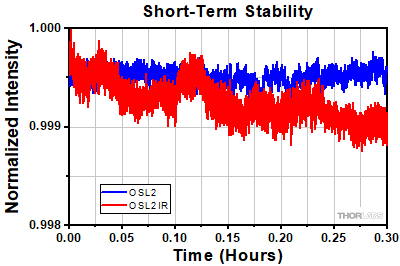
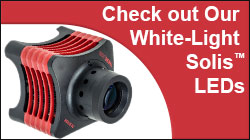
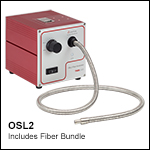
 Zoom
Zoom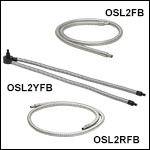
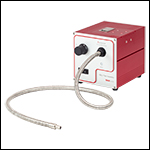
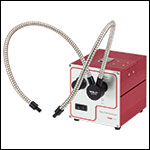
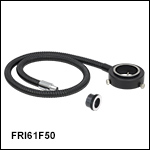
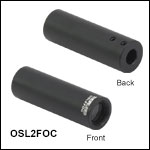
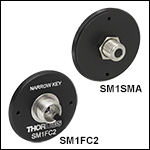
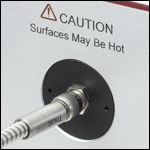
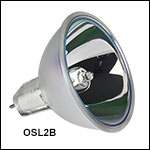
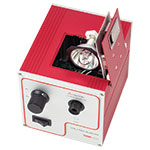
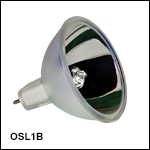
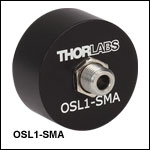
 Fiber-Bundle-Coupled Tungsten-Halogen Light Source
Fiber-Bundle-Coupled Tungsten-Halogen Light Source